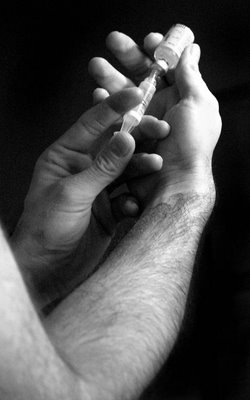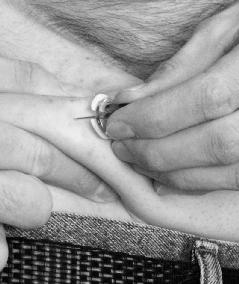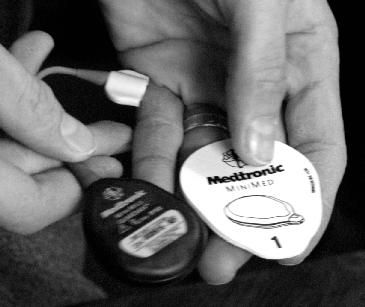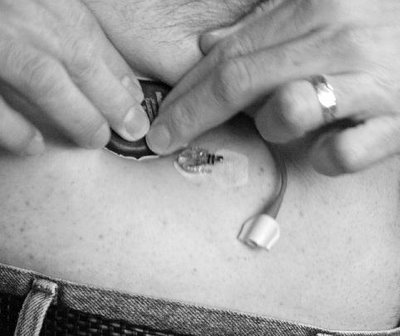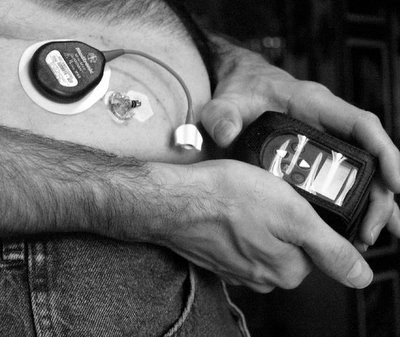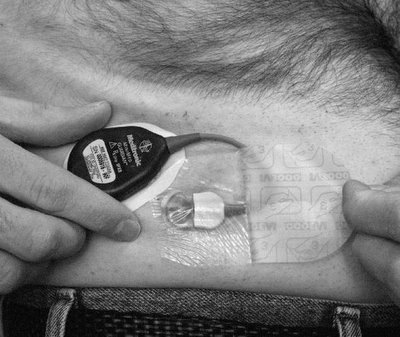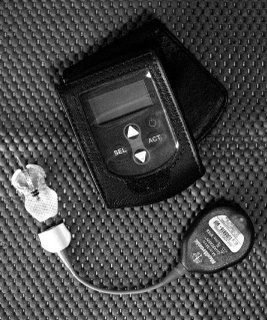
OK, time to dig into the nitty-gritty of the system. Warning! This is a long post, even by my standards. You might as well brew a cup off coffee, put a DVD on for the Kids, send your mate out on a shopping spree, and find a comfy spot to sit and read!
There are three components to the system and a couple of accessories. From the body out-wards the components are: the Glucose Sensor, the Transmitter, and the Monitor. Oddly, while we have a transmitter, we have no receiver--the monitor does the receiving. Hey don't blame me, I'm just the fan club. No one at Medtronic consulted me when naming the parts!
Accessories include the computer dock called the Com-station and software named Guardian Solutions, the Sen-serter for quick insertion of the sensors, a Test Plug for diagnostics, a leather belt case for the Monitor, and even a screw driver for the monitor's battery door.
Everything arrives at your door satisfying packaged in black-foam filled boxes with custom cut outs for every piece of the system. Appealing to the photographer in me, it reminded me of a well organized camera bag. Which is moot of course, because it all goes “to work” at once and will never be put back in the box again! I'm sure the real purpose is to protect the gear in shipping anyway.
We've talked quite a bit about the sensors, but I'll review. You'll spend nearly five thousand dollars on sensors over the course of the year. (But if you add up how much you spend on test strips now, you’ll probably have a heart attack.) The sensor is inserted under your skin much like an infusion set and reads glucose from your interstitial fluid. I.F. is the liquid between your cells. Biology 101: your body runs on glucose. It is the energizer battery that fuels your brain, lungs, heart, and all of your muscles. It is sometimes hard to grasp, as we diabetics often view sugar as poison; but all of our cells “eat” sugar. Everything you put into your mouth, from T-bone steaks to Twinkies turns into sugar. Some foods just do it faster than others. The cells get their meals from the sugar in the interstitial fluid. Bottom line, there is a direct correlation between your blood sugar and you I.F. sugar. I don’t honestly know if the numbers are really the same but the Guardian gives us BG readings based on the readings it takes from the I.F. I can personally attest to the fact that the readings are very accurate. Over my first two days I’ve been taking quite a few finger sticks to compare the Guardian readings to the readings of my traditional meter. I’ve been astounded by how close the two are. I already have great confidence in the readings from my Guardian.
What else can I tell you about the sensors? They are pink. Well, maybe pale purple. Although....Now that I look at the one on my bod again it looks clear now. Hmmm....do they change color as they get used up? Interesting. Well time will tell, I’m still on my first set, you know. The sticky pads are really well designed. You pull the front part off before inserting, once it is on your skin there is a pull tab that cleanly, quickly, and simply exposes the back half. A breeze to stick on. And it sticks really well. Like an infusion set, once in, you pull out the guide needle that you used to insert. That leaves just the flexible probe inside of you. They look a little more substantial than the Teflon cannaula of an infusion set, but I don’t feel a thing. You can insert manually like I did, and will probably continue to do; or you can use the inserter. Looks well designed, and I think it will be easier for most folks to go that route. So the sensor’s job is to measure the glucose in your I.F., and send that information to the transmitter.
The transmitter looks like one of those things you use to open your car as you walk up to it. Do those actually have a name? I suppose they do, but I don’t know what it is. When I first saw the transmitter I was appalled. It looked so
big. I’m going to have to wear
that on my body 24-7 for the rest of my life? You gotta be kidding! It seemed, big, heavy, and thick. I was thinking, I’ll never be able to wear a tight shirt again. Women are going to ask me, “is that a Guardian transmitter in your pocket, or are you just happy to see me?” I thought, this thing is gonna wake me up at night if I roll over on it.
Don’t panic.In fact, in real life use it is no bother at all and I don’t even know it is there. The actual size is about two inches long, inch and a half wide, and a little over a quarter of an inch thick. It has a short wire that plugs into the sensor. It is slightly tear-dropped shaped and is held on to your skin using a really nifty tape. The tape is a thin foam pad. Same shape as the transmitter and slightly larger. You affix the tape to the back of the transmitter, then stick it on your body. It must breath a little bit, because it is very comfortable. Stays on really well too.
The transmitter, according to the manual, “receives and process signals from the sensor, and it sends the signals by radio frequency to the monitor.” It is a totally sealed unit. All you do is put it on. Everything is controlled from the monitor. Because the transmitter is sealed up, to make it water proof I assume, the batteries can not be changed. Just like the first generation I-Pod, when the batteries die, you gotta buy a new one. $400. Once per year.
The monitor looks like a garage door opener. Or maybe a pager. Not sexy or flashy, but conformingly beautiful in a no-nonsense utilitarian kinda way. The size is three and one-half inches top to bottom, two and a half inches side to side and about an inch thick. First impression here is too big too. But once you are wearing it, it takes up surprisingly little room. Of course you don’t have to wear it. It is wireless. I chose to wear it because that works with my life style and wardrobe. But you could carry it in a brief case or purse.
Five buttons control everything. Actually, in point of fact, four buttons control everything because one button is the on and off button and I can’t imagine a situation in which I’d turn it off. There are two arrow buttons, one up and one down. They are in the center of the monitor. On the left is a button called “Sel,” which stands for “select.” You use it to navigate among the different screens. On the left is a button called “Act,” which stands for “activate.”
Using one or more of the buttons in various combos lets you program, control, and respond to the monitor. Sounds worse than it is. In fact, I’ve found the systems to be well thought out and very intuitive. This is not a hard machine to learn at all, and in the next few days I’ll start digging into details of operational use.
There is a nice little leather case too. It has been well engineered so that the heavy duty belt clip on the back on the monitor is still used (the clip is removable). There is a clear vinyl window that covers the controls and view screen, covered by a flap with a Velcro tab. When you are wearing it, it becomes a inoffensive little black box on your belt. Won’t arouse any attention at all. When you want to check your sugar, slip it off, open the flap (which I can do one-handed) and press “Sel.” That gives you your sugar at this very moment. Mine is 111, thank you for asking. What’s yours? Well, while you are looking for your test strips, meter, and lancet, I’m going to go check on the Turkey.
I haven’t used the computer dock yet, I wanted to wait until I actually have a couple of days of data to look at, so I’ll review that and the software in a future post. A quick story to close with. I had to drive down to Albuquerque last night (never mind why, if I go into that story this post will become a novel).
When I jump into a car I’m in the habit of checking my sugar, assuming I’m the driver that is. So last night I just flipped open my case....I didn’t even need to take the Guardian off my belt. I pressed the “Sel” button and looked down. We were good to go.
Coming down Terijas Canyon on I-40 my pump started buzzing. It had been two hours since my last bolus. I’m sure you all know about Interstate BG checks. Do you pull off the highway and risk getting creamed by a semi truck that wanders briefly on the shoulder? Or do you balance your pump on top of the steering wheel, the infusion set hose not quite reaching while you hold your lancet in your teeth, opening the vial of test strips one handed, dumping half of them on to the floor....Did I mention that this is after dark?
But this time it was so easy. I cancelled the pump alarm by feel. Slipped the Guardian off of my belt one-handed, flipped open the case with my thumb. Pressed the down arrow to turn on the back light...greenish blue...and pressed the Sel button. She displayed my “Now” BG. How cool (and safe!) is that?
Also:
$2700 machine
$ 40 sensor
$ 26 in gasoline
Driving without fear of hypoglycemia? Priceless.
Happy Thanksgiving everyone!











